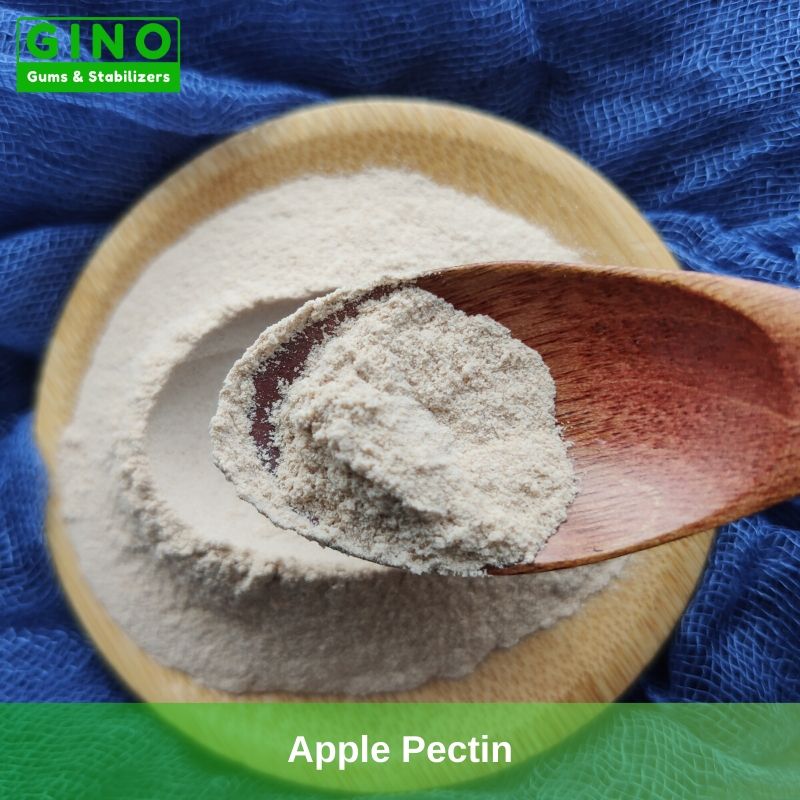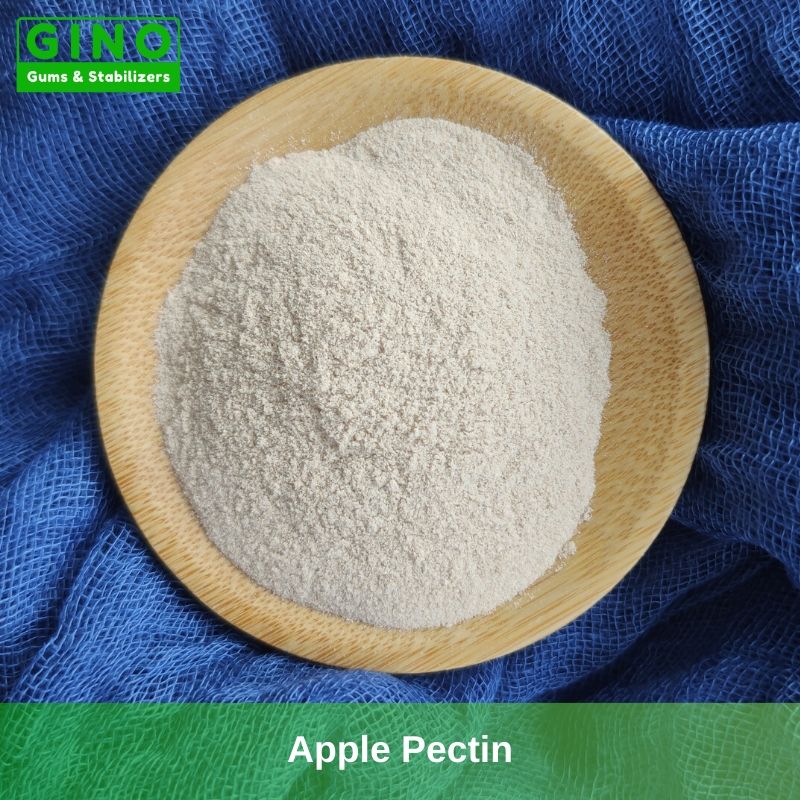LMC Apple Pectin
Best-Selling E440 Conventional Low Methoxyl (LMC) Apple Pectin Producer
Pectin is a natural plant-based hydrocolloid found in fruits, and, Apple pectin is a type of soluble fiber found naturally in apples. Importantly, it is used in food as a gelling agent, particularly in jams and jellies.
As one professional apple pectin producer, supplier, exporter in China, Gino is dedicated to providing superior pectin products. Meanwhile, we can offer tailor-made solutions perfectly matched to your needs.
Contact us to ask about a single hydrocolloid gum or food stabilizers (blends & systems) that would work for your products. Should you have any questions please feel free to send an email to [email protected].


LMC Apple Pectin
| Category | Thickeners, Stabilizers |
|---|---|
| E Number | E440 |
| CAS No. | 9000-69-5 |
| H.S. Code | 1302200000 |
| Origin | China |
| MOQ | 500 KG |
| Packaging | Cartons, Bags |
| Payment Term | T/T, L/C |
GINO_HM Apple Pectin Supplier | Apple Pectin Producer
What is LMC Apple Pectin?
Apple pectin is extracted from apples and it is usually sold in powder form. It can be used as a gelling and thickening agent, as well as a food stabilizer.
LMC Apple pectin is a conventional low methoxyl pectin, extracted from apple pomace and standardized with sucrose.
It’s often used for low-calorie jams and jellies since it relies on calcium instead of sugar to solidify. It’s great for dairy-based recipes that don’t need sugar, too. LMC pectin gets increasingly firmer as calcium is added until it hits a saturation point. At that time, the process reverses and it becomes less firm.
Types of Pectin
There are three types of pectin if classified by degree of esterification (DE).
- High Methoxy Pectin (HMP). DE > 50% (typically 55-75%).
- Low Methoxy Pectin (LMP). DE < 50% (usually 20-40%)
- Low Methoxy-Amidated Pectin (LMAP): <25% amidation, 25%
- HMP and LMP have the same E number as E440i, while LMAP has a similar E number as E440ii.
High methyl-esterified forms gels in high soluble solids and acidic systems, whereas low methyl-esterified forms gels in a much broader pH and soluble-solids range, but requires the presence of divalent cations for gelling.
Commercial pectin is primarily extracted from citrus peel and apple pomace. If on the basis of origin, it can be divided into Apple Pectin and Citrus Pectin.
Our Product Range
LMC Apple Pectin Specification
Low Methoxyl High Calcium Reactivity Pectin | Low Methoxyl Medium Calcium Reactivity Pectin |
Sensory characteristics Appearance: Free flowing powder. Colour: Pale brown. Odour: Neutral, free from off-odours. Taste: Neutral, free from off-flavours.
Specification pH (1% solution): 3.0 – 3.8 Reactivity to calcium: High Degree of esterification: 30– 35% Pectin content: ≥60 %
Chemical characteristics Galacturonic acid: ≥65 % Loss on drying: ≤12 % Ash ,total: ≤5% Acid-insoluble ash: ≤1 % Nitrogen content: ≤1 % SO2: ≤50ppm Free methyl, ethyl and isopropyl alcohol: ≤1 % Heavy metals as lead: ≤15ppm Lead: ≤5ppm Arsenic: ≤3ppm Particle size: 1% retained on 300μm
Microbiological characteristics Total plate count: ≤ 1000 cfu/g Yeast and mould: ≤ 100 cfu/g Coliforms: Absent in 1 g E. coli: Absent in 1 g F. Staphylococcus aureus: Absent in 1 g Salmonella: Absent in 25 g | Sensory characteristics Appearance: Free flowing powder. Colour: Light brown. Odour: Neutral, free from off-odours. Taste: Neutral, free from off-flavours.
Specification pH (1% solution): 3.0 – 3.8 Reactivity to calcium: Medium Degree of esterification: 36– 40%
Chemical characteristics Galacturonic acid: ≥65 % Loss on drying: ≤12 %
Acid-insoluble ash: ≤1 % Nitrogen content: ≤1 % SO2: ≤50ppm Free methyl, ethyl and isopropyl alcohol: ≤1 % Heavy metals as lead: ≤15ppm Lead: ≤5ppm Arsenic: ≤3ppm Particle size: 1% retained on 300μm
Microbiological characteristics Total plate count: ≤ 1000 cfu/g Yeast and mould: ≤ 100 cfu/g Coliforms: Absent in 1 g E. coli: Absent in 1 g Staphylococcus aureus: Absent in 1 g Salmonella: Absent in 25 g |
Nutritional information depends on the standardisation Energy (per100g): Typically 550 - 650kJ Protein: Typically < 0.5% Carbohydrates : 15 – 25% Of which sugars: 15 – 25% Fat: < 0.5% Fibre: Typically 75 – 85% | |
Use as a gelling agent in systems with soluble solids of <50% Use Level: Jams, Jellies: 0.5%-1.5% | |
LMC Pectin Properties
Gel formation properties of pectin: The most important use of pectin is based on its ability to form gels.
HM pectin forms gels with sugar and acid.
LM pectin requires the presence of divalent cations for proper gel formation.
LM pectin gets increasingly firmer as calcium is added until it hits a saturation point. At that time, the process reverses and it becomes less firm.
LMC Pectin Advantages
- One of the attractive features is that the pH at which pectin has optimal stability matches the natural pH of fruit preserves. Compared to other hydrocolloids, this feature is unique to pectin.
- Another advantage is related to the texture which is physically and also organoleptically optimal.
- Finally, it gives an excellent flavor release due to its relatively small molecular weight when compared to other hydrocolloids.
LMC Pectin Benefits
Pectin, along with three other ingredients such as cellulose, guar gum, and locust bean gum, is defined by the FDA as a dietary fiber that is beneficial to our health, with the following benefits.
- Lowers blood sugar/blood pressure
- Keeping cholesterol in the blood
- Relieves constipation
- Increase satiety and decrease energy intake
Pectin has the ability to reduce low-density lipoprotein (LDL) levels, thereby lowering cholesterol levels, and its ability to slow the passage of food through the intestine, relieving diarrhea. Pectin can also activate cell death pathways in cancer cells, indicating that pectins may play an important role in preventing certain types of cancer.
lMC Pectin Uses
- What is pectin used for?
Uses of pectin in food industry:
Low-methoxyl pectin is widely used in the food industry as a thickening agent for low-calorie jams and jellies.
Low-methoxyl pectin is applicable in dessert fillings; sweets; and as a thickener and stabilizer in fruit juices, drinking yogurt, milk drinks, hair tonics, body lotions, shampoos, and conditioners.
Uses of pectin in cosmetics industry:
In cosmetics, low-methoxyl pectin is used as a structure provider in pastes, ointments, oils, and creams.
Uses of pectin in pharmaceutical industry:
In medicine, pectin is used to prevent disorders, such as constipation and diarrhea, mouth & throat sores, diabetes, and colon cancer.
How to Use Pectin
- How to use pectin to make jelly
Pectin is the most crucial ingredient in making fruit jelly, it’s what creates the gelling effect that you’re aiming for.
For more info about how to make jelly with pectin, please click HERE.
Frequently Asked Questions
- See below for commonly asked questions about pectin
What is pectin?
Pectin, a natural polysaccharide, is commonly used as a gelling agent, thickener, emulsifier and stabilizer in food, European food additive number E440. It is made mainly from citrus peel and apple pomace and is commonly used in jams and jellies.
What is pectin made of?
Food grade pectin is a high molecular weight polysaccharide that consists of two parts: more than 65% galacturonic acid, and 35% other polysaccharides and some small amounts of monosaccharides.
What is pectin manufacturing process?
The basic principle of pectin extraction is to break down raw pectin (in the form of raw pectin, pectic acid, and pectate) into water-soluble pectin, which is then separated from cellulose, starch, protein, pigment, and other components.
What is pectin structure?
The basic structure of pectin consists mainly of D-galacturonic acid units, which are polymerized by α-1,4 glycoside linkages, with some of the carboxyl groups on the galacturonic acid residues in the form of methyl esters (methylated).
The remaining carboxyl groups on galacturonic acid are present as free acids or as salts of potassium, sodium, ammonium, and calcium.
The percentage of total galacturonic acid reflects the purity of the pectin, which should contain not less than 65% of food grade.
How much apple pectin should i take daily
The proper amount of apple pectin to use is not specified, although most manufacturers usually recommend a daily dose of between 1,000 mg and 1,400 mg. It's best to take it 30 minutes before a meal so it can bind to excess water, fat, or carbohydrates in the gut.
Is pectin safe? Is pectin healthy?
Yes, it has virtually no side effects and its safety has been recognized by the U.S. Food and Drug Administration (FDA) and the European Food Safety Authority (EFSA), as well as the Joint FAO/WHO Expert Committee on Food Additives (JECFA).
Is pectin safe for dogs?
Pectin is considered safe for dogs over sixteen weeks of age. However, you should always consult your veterinarian when making health decisions, not internet articles.
Is pectin safe during pregnancy?
In most people, including adults, children, and women who are pregnant or breastfeeding, pectin MAY be safe in the amounts taken in food; it MAY be safe when used in larger medicinal amounts.
Is modified citrus pectin safe?
Modified citrus pectin is considered generally safe (GRAS) by the U.S. Food and Drug Administration (FDA). There were only mild side effects reported in clinical studies, including bloating, gas and loose stools.
Is pectin vegan? Is pectin vegetarian?
Yes, pectin is vegan, as it occurs naturally in fruit and no animal-derived products are used in its manufacture, making it suitable for a vegan diet.
Is pectin Halal?
Yes, pectin is a halal food, in line with Muslim policy.
Is pectin Kosher?
Yes, pectin can also be approved for Kosher. Our gellan gum manufacturer could also provide Kosher certificate.
Is pectin bad for you?
Pectin isn’t bad for you. But pectin needs a lot of sugar to work - about two-thirds to one-half of the jam you use it in.
High sugar content is standard in jams and jellies, but that sugar is still bad for you: it can rot your teeth, add to your weight through blood sugar spikes, and put you at risk for long-term diseases like diabetes.
Be aware of your sugar intake and use your best dietary judgment when consuming products that contain pectin. Of course, pectin is a fiber, so it will reduce some of the high sugar content.
Is pectin gluten free?
Yes, it is gluten-free because it does not contain wheat, rye, barley or hybrids of these grains.
What are pectin nutrition facts?
Pectin is a fiber and contains almost no calories or nutrients.
What are pectin side effects?
Pectin can cause stomach cramps, diarrhea, gas, and loose stools.
What are e440 pectin substitute?
- Citrus peels. Citrus peels—especially the white part, or pith—are naturally packed with pectin. ...
- Corn starch. Corn starch is a natural thickener that works as a seamless substitute for pectin.
- Gelatin. Gelatin is a viable option for non-vegans or non-vegetarians.
- Extra sugar.
- Related Products
- Contact Form
Need to find the best reliable E440 pectin producer, supplier, exporter in China? As one professional apple pectin and citrus pectin manufacturer and supplier in China., all grades and forms of pectin products could be provided by Gino. We could help you find the perfect pectin for your application. Please complete the fields below and we will respond to you as soon as possible.



